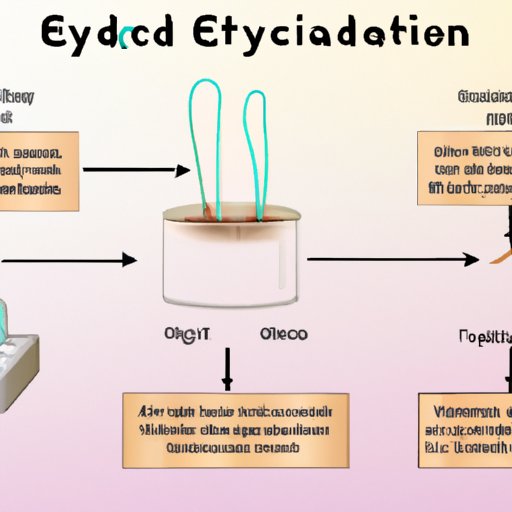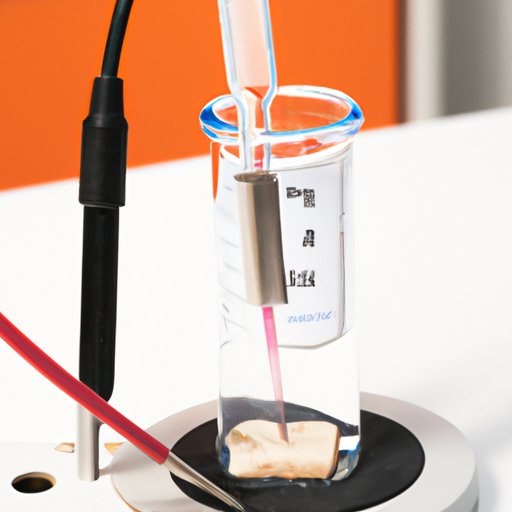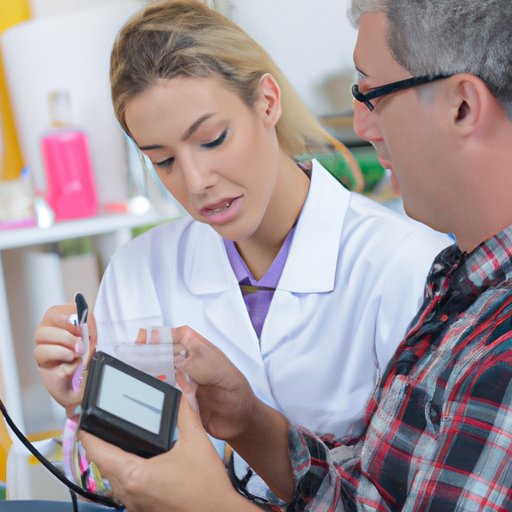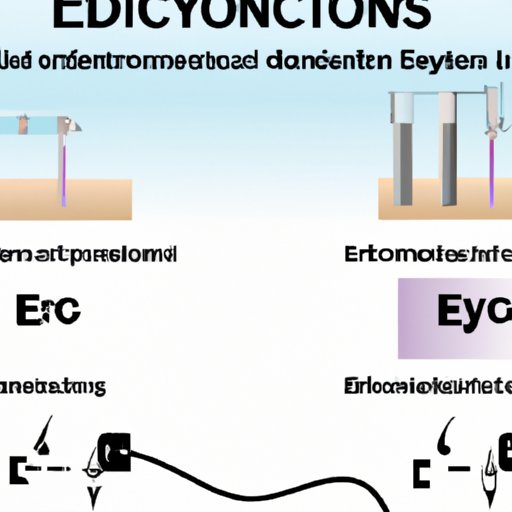Introduction
Electrolysis is a process that uses electrical current to move ions through a solution or other medium. It has many uses, such as in industry and research, and can be used to solve a variety of problems. But what exactly is electrolysis and how does it work? This article will explore the science and chemistry behind electrolysis and provide an overview of the process and its applications.
Exploring the Science Behind Electrolysis
The first step in understanding electrolysis is to understand what electrolytes and ions are. An electrolyte is a substance that contains ions, which are atoms or molecules that have an electric charge. When electricity is applied to an electrolyte, the ions move towards the oppositely charged electrode, resulting in a chemical reaction. Depending on the type of electrolyte, different types of reactions can occur.
There are two main types of electrolysis: direct current (DC) and alternating current (AC). In DC electrolysis, the electrical current passes directly through the electrolyte and results in a single chemical reaction. In AC electrolysis, the electrical current alternates between electrodes and causes multiple chemical reactions.

An Overview of the Process of Electrolysis
In order to perform electrolysis, several components are needed. These include an electrolyte, two electrodes, and a power source. The electrodes are connected to the power source and placed into the electrolyte. When the power is turned on, electrical current passes through the electrolyte, causing chemical reactions to occur at the electrodes.
The process of electrolysis is fairly simple, but there are some safety concerns to consider. For example, if the electrolyte is flammable, sparks from the electrodes could cause a fire. Additionally, the electrodes can become hot during the electrolysis process, so proper safety precautions should be taken when handling them.
How Electrolysis is Used in Different Applications
Electrolysis has many uses in industry and research. For example, it is used in the production of chlorine for use in swimming pools and water treatment systems. It is also used in electroplating, which is the process of coating metal objects with a thin layer of another metal. Additionally, electrolysis is used in the production of aluminum, copper, and other metals.
Electrolysis can also be used in medical and cosmetic applications. For example, electrolysis is used to remove unwanted hair, as well as to treat certain skin conditions such as acne and wrinkles. Additionally, electrolysis is used in the treatment of certain medical conditions, such as chronic pain.

Examining the Chemistry of Electrolysis
The chemistry of electrolysis involves several electrochemical equations. In the most basic form, electrolysis involves the oxidation and reduction of ions. Oxidation occurs when electrons are removed from an atom, while reduction occurs when electrons are added to an atom. As a result of these reactions, new products are created, such as hydrogen gas and oxygen gas.
The products of electrolysis depend on the type of electrolyte being used. For example, in the electrolysis of water, the products are hydrogen and oxygen gas. In the electrolysis of sodium chloride (salt), the products are chlorine gas and sodium hydroxide.

Investigating the Benefits of Using Electrolysis
Electrolysis has several advantages over other methods of chemical reactions. For example, it is a faster and more efficient way to produce certain chemicals. Additionally, electrolysis is less expensive than other methods, as it does not require the use of expensive catalysts or reagents. Finally, electrolysis is a safer method of producing chemicals, as it does not require the use of high temperatures or dangerous chemicals.
In addition to its industrial applications, electrolysis has many practical uses. For example, it can be used to clean coins and jewelry, as well as to remove rust from metal objects. Electrolysis can also be used to purify water, and to separate oil and water mixtures.
Understanding the Principles of Electrolysis
At the heart of electrolysis is the principle of electrical current. Electrical current is generated by a battery or other power source, and this current is used to move ions through a solution or other medium. As the ions move, they undergo chemical reactions, resulting in the formation of new products.
The electrical current used in electrolysis must be of a specific magnitude and duration in order for the process to work correctly. If the electrical current is too low, the ions will not move; if the electrical current is too high, the chemical reactions can become dangerous. As such, it is important to use the correct amount of electrical current when performing electrolysis.
Conclusion
This article explored the science and chemistry behind electrolysis. We discussed the components needed for electrolysis, the process itself, and the various applications and benefits of using electrolysis. We also examined the principles involved in the process, such as the role of electrical current. Finally, we looked at the electrochemical equations involved in electrolysis and the products that are formed.
Understanding how electrolysis works can help us solve a variety of problems. From industrial and medical applications to everyday tasks, electrolysis can be used to make our lives easier. If you’re interested in learning more about electrolysis and its applications, consider taking a course or reading up on the topic.
(Note: Is this article not meeting your expectations? Do you have knowledge or insights to share? Unlock new opportunities and expand your reach by joining our authors team. Click Registration to join us and share your expertise with our readers.)
